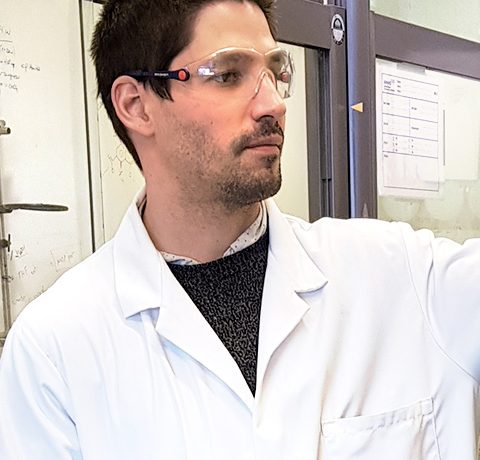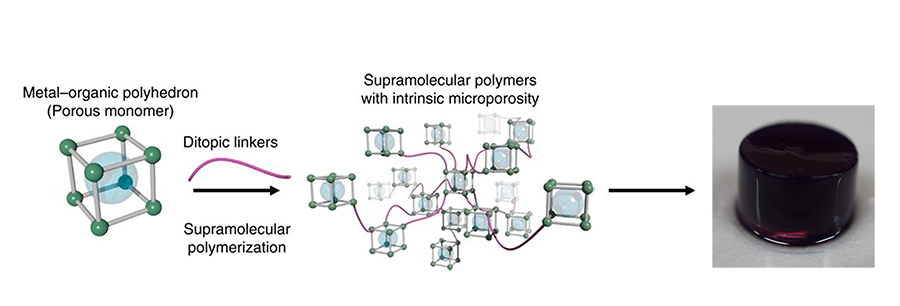Juan-de-la-Cierva Postdoc at the Catalan Institute of Nanoscience and Nanotechnology at the Barcelona Institute of Science and Technology (Spain).
JSPS postdoctoral fellow in the Shuhei Furukawa group in Kitagawa Lab, at the time working on this research
Arnau Carné-Sánchez
Arnau Carné-Sánchez
Dr Arnau Carné-Sánchez has uncovered a new methodology to control porosity in amorphous, soft coordination polymers in the form of nanoparticles or gels. This is an important step to making porous materials easier to process and to facilitate their practical use.

Please share with us the significance of your manuscript in terms of its research achievements, impact, or uniqueness.
Porous materials are important because they are essential in fundamental industrial processes such as gas storage, catalysis, and separation. For example, CO2 capture by porous materials is considered to be one of the most viable strategies to managing the current issue of excessive CO2 emissions into the atmosphere. The success of porous materials is dictated by the degree of control that is achieved by their pore size. The general approach to the synthesis of porous materials with controlled pore apertures is based on linking small molecules into crystalline extended networks in which the pores come from the architecture of the network. This strategy has the limitation of producing materials that are difficult to tailor morphologically, which is an important consideration for materials processing and hinders their practical application.
We thought that we could start by building from the pore. By introducing the porous unit at the beginning of the reaction as a building block, its presence would be ensured by the components of the network and not only by the overall structure. This way, we would have more freedom to think about the final morphology of our materials and how to shape them, without worrying about crystallinity and long-range order. To do this, we used pre-formed, porous molecules as building blocks, or as we began to call them “porous monomers,” in the coordination polymerization reactions.

What would you say is the most exciting or “I made it!” moment during this research project?
Without any doubt, the moment I will never forget is the first time I saw that our molecules were successfully polymerized in the form of a purple, transparent gel. To see that the reaction we had imagined the night before occurred as we expected, and that the result of this reaction was a macroscopic material, was one of the most satisfying moments of my research career.
Please tell us about the biggest challenge or problem you experienced while conducting your research. How did you overcome it?
Once we saw that the reaction worked we wanted to know its mechanism. This was challenging because we were a team used to working with crystalline materials and so this was the first time that we had to determine how an amorphous material was formed. We had to use and combine different characterization techniques to demonstrate that the key to our polymerization technique was the formation of a kinetically trapped molecule. The characterization of these molecules is challenging as they are not very stable in time and are difficult to crystallize. We solved the puzzle by combining UV-VIS spectroscopy to determine the coordination of the linker with the porous monomer, using light scattering to see its size evolution, and NMR to determine its composition.
Would you consider this work to be a turning point in your overall research direction? If so, how has your research direction changed as a result of this work?
Definitely this work is a turning point in my career. This project gave me the opportunity to know these “porous monomers.” I realize that these molecules offer us the freedom to design porous materials free from the restriction imposed by conventional porous crystalline materials. I intend to use this freedom to fabricate new soft materials which marry the exceptional processability of organic polymers with the controlled porosity of porous monomers to achieve soft matter that is both permanently porous and amenable to materials processing. These materials would not only be scientifically relevant but would also represent a step forward in the implementation of supramolecular microporous materials for real world applications.
Please describe the current situation of your career. What is your current position? How has the knowledge and experience gained at iCeMS influencing your career?
I am currently a postdoc researcher at the Catalan Institute of Nanoscience and Nanotechnology (ICN2) in Barcelona. The experience which I acquired at iCeMS was key to achieving my current position and also helped me to gain scientific independence.
Finally, please give a message or advice to young iCeMS researchers.
iCeMS is a great place to do research. It is a multidisciplinary research center where one has the opportunity to exchange ideas with fellow researchers in different fields. I advise everybody working in iCeMS to take advantage of this to learn about other scientific fields. iCeMS retreats are a good opportunity for that!
*All the information on this page, including the researcher’s affiliation, is current at the time of the interview.
Paper information
Self-assembly of metal–organic polyhedra into supramolecular polymers with intrinsic microporosity
Arnau Carné-Sánchez, Gavin A Craig, Patrick Larpent, Takashi Hirose, Masakazu Higuchi, Susumu Kitagawa, Kenji Matsuda, Kenji Urayama, Shuhei Furukawa.
Nature Communications
Published: July 2018
DOI: 10.1038/s41467-018-04834-0